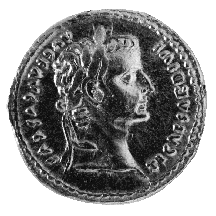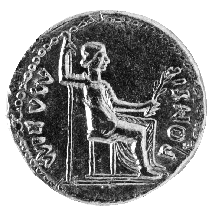



(70) Tiberius - AV aureus, c. A.D. 15-37, 7.74 g. (inv. 91.118).
Obverse: Laureate head of Tiberius r.; TI(BERIVS) CAESAR DIVI AVG(VSTI)
F(ILIVS) AVGVSTVS: Tiberius Caesar, son of the Divine Augustus, Augustus.
Reverse: Livia or Pax seated r., holding scepter in r. and branch in l.;
PONTIF(EX) MAXIM(VS): pontifex maximus.
Provenance: Abner Kreisberg, 1974.
Bibliography: C.H.V. Sutherland, The Roman Imperial Coinage I: from 31
BC to AD 69. rev. ed. (London 1984) 25.
Tiberius, born in 42 B.C., became the stepson of the future Augustus when
his mother, Livia, married Octavian in 38 B.C. When it became clear that
Augustus intended his grandsons, Gaius and Lucius Caesar, as his heirs,
Tiberius went into morose exile on Rhodes, but after the untimely deaths
of the two boys Augustus adopted Tiberius, and he became a loyal and successful
general in Augustus' wars in Germany. When Augustus died in A.D. 14, Tiberius
inherited the throne. He deified Augustus immediately after his death and
pursued Augustan policies with little change. He assumed the office of pontifex
maximus, the chief priest of Rome, in A.D. 15. His reign was relatively
peaceful, spent largely in Rome and in seclusion in his villas on the island
of Capri. He died in A.D. 37 at the age of seventy-eight.
From the age of four Tiberius had lived in the shadow of Augustus, and his
gold and silver coinage concentrates almost exclusively on his relationship
to his divine predecessor and other members of his family and on personifications
of imperial virtues. The coins have none of the references to imperial achievements
that had characterized the coinage of Augustus. Even his portrait shows
strong Augustan influence, probably another way of emphasizing the relationship
and the legitimacy of his succession. The hairstyle, with its locks combed
down on the forehead, is very similar, as is the general idealized quality.
He differs from Augustus, however, in his broad forehead and very large
eyes, noted by the biographer Suetonius (Tiberius, 68).
The reverse depicts a seated figure, sometimes identifed as Tiberius' mother
Livia and sometimes as Pax, the personification of peace, with her standard
attributes, a scepter and palm branch.
C.L.L.



All contents copyright (c) 1996.
Lawrence University
All rights reserved.